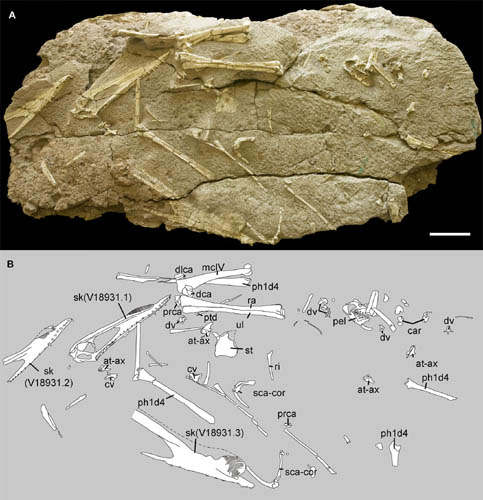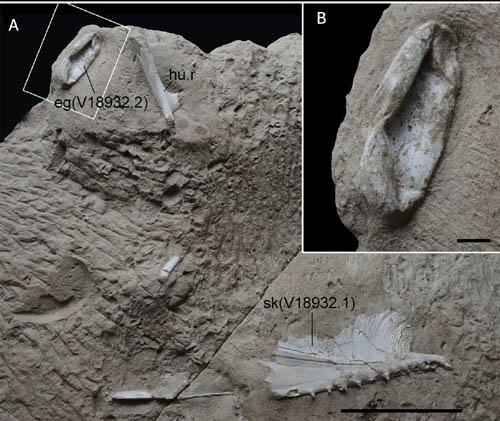
The pterosaur record is generally poor, with little information about their populations, and pterosaur eggs are even rarer, with only four isolated and flattened eggs found to date. Dr. WANG Xiaolin, Institute of Vertebrate Paleontology and Paleoanthropology (IVPP) of the Chinese Academy of Sciences, and his team revealed a new pterosaur-rich area with potentially thousands of bones, including tridimensionally preserved male and female skulls and eggs discovered together for the first time in the Early Cretaceous deposit of the Turpan-Hami Basin, south of the Tian Shan Mountains in Xinjiang, northwestern China. Researchers reported a population of a new sexually dimorphic pterosaur species (Hamipterus tianshanensis gen. et sp. nov.), with five exceptionally well-preserved three-dimensional eggs online June 06 in Current Biology, providing new and important evidence regarding male and female morphologies, reproduction, ontogeny, and eggshell microstructure.
The pterosaurs are well preserved, with the white-colored bones showing little distortion. About 40 individuals (wingspan 1.5–3.5 m) were recovered in a small area, but the actual number might be in the hundreds, all from part of the Lower Cretaceous Tugulu Group, which was formed under fluvio-lacustrine conditions. In the sedimentary sequence, there are some tempestite interlayers, in which the gray-white sandstones and brown mudstone breccias that were deposited at different depths of the lake are mixed together. Tempestite interlayers where nearly all of the pterosaur fossils are found suggest that large storms caused the mass mortality, event deposits, and lagerstätte of the pterosaur population.
The new species name, Hamipterus tianshanensis, is a reference to the region where the specimens were found. “Hami” refers to a city in Xingjiang and "pteros" in Greek means “wing”, and "tianshanensis" refers to the Tian Shan Mountains in Xinjiang. This region was added to the UNESCO World Heritage List in 2013. Several features indicate that Hamipterus is a member of the derived pterodactyloid clade Pteranodontoidea.
All of the discovered skulls have crests, which exhibit two different morphologies in size, shape, and robustness. Two skulls of about the same size show different crests, one larger with a more rugose surface and a strongly curved anterior margin, starting before the sixth alveolus, and the other smaller, less rugose, and placed further backward, starting beyond the sixth alveolus. Although morphological variation could be interpreted as individual variation, these marked differences suggest that the skulls belong to different genders. Researchers interpreted the specimens with larger crests as males and those with smaller crests as females.
The main ontogenetic changes observable in Hamipterus are the expansion of the rostral end and the premaxillary crest, both of which become progressively more robust. Furthermore, in larger individuals of the new species, the cranial crest starts at the fifth alveolus instead of the sixth, and ridges and grooves become more apparent. The rostral end is deflected dorsally in smaller individuals but is straight in larger ones, and the dentary fossa is more elongated and deeper in larger individuals as well. The number of teeth and the proportional sizes of the mandibular symphysis remain constant.
Besides the bones, a total of five eggs were recovered from the same site. All show three-dimensional preservation and are elongated and slightly asymmetrical. Most are 59–65 X 34 mm in size (about 40–50 g). One egg is comparatively small (29.6 X 22.8 mm; about 14 g) and likely not fully developed. “Due to the close proximity to Hamipterus tianshanensis, the sole taxon found at the site, all of the eggs are referred to this species. The eggs show pliable depressions with cracking and crazing on the outer surface. The eggshell, observed by scanning electron microscopy and energy-dispersive spectroscopy, comprises a thin calcareous external hard shell followed by a soft membrane”, said study co-author Dr. Alexander Kellner, Nacional/Universidade Federal do Rio de Janeiro of Brazil, “We propose that such an eggshell structure, similar to that of some snakes, may well explain the preservation of the outer surface observed in pterosaur eggs”.
The combination of many pterosaurs and eggs indicates the presence of a nesting site nearby and suggests that this species developed gregarious behavior. Hamipterus likely made its nesting grounds on the shores of freshwater lakes or rivers and buried its eggs in sand along the shore, preventing them from being desiccated. “Further questions regarding matters such as colonial nesting, fidelity to nesting grounds, and clutch and parental care remain open, but sites like the one reported here provide further evidence regarding the behavior and biology of this amazing group of flying reptiles that has no parallel in modern time”, said lead author Dr. WANG Xiaolin of the IVPP, “We suggest that this new pterosaur nested in colonies and thus exhibited gregarious behavior, a possible general trend for at least derived pterodactyloid pterosaurs.”
This study was supported by the National Science Fund for Distinguished Young Scholars, the National Basic Research Program of China, the Hundred Talents Project of CAS, and the Excavation Funding and Emphatic Deployed Project of IVPP, CAS.

Fig.1 Photo (A) and Line Drawing (B) of Hamipterus tianshanensis (IVPP V18931) in a Large Block. This block preserves three skulls, including a complete female skull (holotype, IVPP V18931.1), an incomplete female skull (IVPP V18931.2), and an incomplete male skull (IVPP V18931.3), Scale bar, 10 cm. (Image by WANG Xiaolin)

Fig. 2 Hamipterus tianshanensis with abundant bones and tridimensional eggs. (A), a block (IVPP V18932) with an incomplete skull (IVPP V18932.1) closely associated with an egg (IVPP V18932.2) and a right humerus. The skull is interpreted as belonging to a male due to the large and robust cranial crest, starting above the fifth tooth position. The crest shows developed anteriorly curved ridges and sulci and an arc-shaped anterior margin. Scale bar, 10 cm. (B) Close-up of the deformed egg. Scale bar, 1 cm. (Image by WANG Xiaolin)

Fig. 3 Male and Female Skulls of Hamipterus tianshanensis (A) and (E) are females; (B), (D), and (F) are males; (C) Outline of holotype showing female crest, gray part with white lines shows male crest. Male skulls have larger and thicker crests than female skulls; male crests also have more strongly curved anterior margins than female crests and are positioned more anteriorly. (Image by WANG Xiaolin)

Fig. 4 Comparison of Eggs of Hamipterus tianshanensis (Left) and the Colubrid Snake Elaphe (Right). (Image by WANG Xiaolin)

Fig. 5 Life reconstruction of Hamipterus tianshanensis (Image by ZHAO Chuan)

86-10-68597521 (day)
86-10-68597289 (night)

86-10-68511095 (day)
86-10-68512458 (night)

cas_en@cas.cn

52 Sanlihe Rd., Xicheng District,
Beijing, China (100864)

